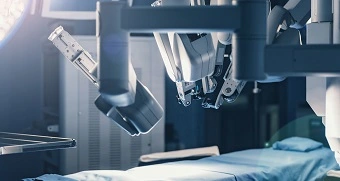Healthcare Robotics: Bridging the Gap Between Technology and Patient Care
24 May 2024 • by Natalie Aster

The advent of healthcare robotics marks a transformative milestone in the medical field, intertwining advanced technology with patient care to revolutionize treatment methodologies. From surgical precision to patient rehabilitation, healthcare robots are set to expand the horizons of medical science.
The Evolution of Healthcare Robotics
Since its debut, healthcare robotics has come a long way. At the outset, robots were utilized for simple tasks such as material handling and laboratory automation. Today, they play crucial in complex surgeries, patient monitoring, and even emotional support for patients. This evolution underscores the significant strides made in both robotic technology and its application in healthcare settings.
Boosting Precision in Surgical Procedures
Robot-Assisted Surgical Operations
One of the standout applications of robotics in healthcare today is in robot-guided surgeries. Robotic systems, for instance, the Da Vinci Surgical System, empower surgeons to carry out highly intricate procedures with superior precision. These high-tech robots provide high-definition 3D vision and superior dexterity, allowing for minimally invasive surgeries. This shortens recovery time, minimizes pain, and minimizes the risk of complications.
Microsurgery and Beyond
Robotic systems are also instrumental in microsurgery, where precision is paramount. Robots can carry out delicate procedures on tiny structures such as blood vessels and nerves, which would be challenging for human hands alone. This capability expands the horizons of what is surgically possible, resulting in better patient outcomes.
Revolutionizing Patient Care
Assistive Devices and Robotic Nurses
Healthcare robotics has found applications beyond the operating room. For instance, robotic nurses, like the TUG robot, can deliver medications, supplies, and even meals, thereby allowing human nurses to prioritize patient care. Assistive robots, such as exoskeletons, help patients with mobility issues regain their independence. These devices are particularly beneficial for patients rehabilitating after strokes or spinal cord traumas.
Patient Monitoring and Support
Equipped with sophisticated sensors and artificial intelligence, robots can keep a constant watch on patients' vital signs. These systems can detect anomalies early, ensuring timely medical intervention. Additionally, social robots, like PARO (an interactive therapeutic robot), provide emotional support to patients, especially to the elderly and those with mental health issues. Offering companionship and reducing feelings of isolation, these robots contribute to overall well-being.
Telemedicine and Remote Care
Robotic Telepresence
Telemedicine has gained considerable traction, particularly in the wake of the COVID-19 outbreak. Robotic telepresence allows healthcare professionals to maintain remote contact with patients. Robots with built-in microphones, cameras, and screens facilitate live consultations, diagnoses, and even remote surgeries. This high-tech solution yields remarkable benefits to patients in rural or underserved areas, ensuring they receive quality medical care without the need to travel.
Remote Rehabilitation
Robots are also pivotal in remote rehabilitation. Devices like the Lokomat enable patients to receive physical therapy from the comfort of their homes. These robots provide personalized exercise regimens and real-time feedback, fostering patients’ recovery at their own pace while maintaining close contact with their healthcare providers.
Challenges and Ethical Considerations
Technical and Logistical Hurdles
Despite the numerous benefits, healthcare robotics faces several obstacles. The costly nature of robotic systems can be prohibitive for many healthcare facilities. Additionally, integrating these systems into existing workflows requires substantial changes and staff training. There are also technical issues, such as software malfunctions and the need for regular maintenance, that must be addressed to ensure smooth operation.
Ethical and Privacy Concerns
The rise of healthcare robotics also brings ethical and privacy concerns. The adoption of robots in patient care requires rigorous data protection measures to keep patient data secure. Ethical concerns, like maintaining human touch and empathy despite robotic integration in healthcare, are also paramount. It is crucial to strike a balance where robots complement, rather than substitute, human care.
The Future of Healthcare Robotics
The promising future lies ahead of healthcare robotics, with continuous technological breakthroughs. Innovations such as nanobots designed for targeted drug delivery and AI-integrated diagnostic robots are on the horizon. As technology evolves, the integration of robotics in healthcare will become more seamless, fostering improved patient outcomes and redefining the landscape of medical care.
In conclusion, healthcare robotics represents a transformative force in the medical field. By bridging the gap between technology and patient care, these advanced systems enhance surgical precision, improve patient care, and expand the reach of telemedicine. While challenges remain, the future holds immense potential for further innovations, promising a new era of healthcare excellence.
Product Details:
Market Publishers boasts a rich collection of in-demand research reports covering various sectors of the healthcare industry, find it in the Healthcare Market Research Reports Catalogue.
CONTACTS
The Market Publishers, Ltd.
Natalie Aster
Tel: +357 96 030922
[email protected]
MarketPublishers.com
Analytics & News
